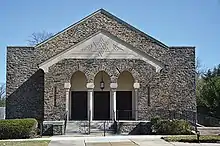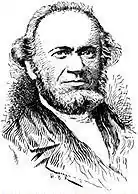for the other United States congregations with the same name, see Shearith Israel (disambiguation); for the historic synagogue in New York, see Shearith Israel.

Congregation Shearith Israel (Hebrew: קהילת שארית ישראל דבאלטימאר; nicknamed The Glen Avenue Shul) is a historic synagogue and congregation in Northwest Baltimore, Maryland.[1] Shearith Israel is noteworthy as being the oldest Baltimore congregation to remain Orthodox throughout its history.
History
Shearith Israel was the second congregation served by Rabbi Abraham Joseph Rice in Baltimore[2] who opened Shearith Israel following his departure from Nidchei Yisrael (known today as The Baltimore Hebrew Congregation).[3] Rice resigned his post in 1849 following the board's decision to reconstitute and adapt certain reforms and their subsequent appointment of Henry Hochheimer.[4]
.jpg.webp)

Rice founded the first synagogue in 1851 on Howard Street in a rented home; it is unclear whether they had a Minyan during the early years.[2] The congregation was to later move to Greene and Redwood Streets (called German Street then, changed during World War I) after it merged with Congregation Shevet Achim of Eutaw Street in 1879 (the building today is used as Calvary Methodist Episcopal Church South).
McCulloh Street Synagogue
At approximately 1905, the congregation built the McCulloh Street Synagogue in the American neo-Romanesque style (with Moorish capitals, eastern-Gothic turrets, and a distinctive ocular window at the entrance). This Synagogue was sold, approximately 1935, to become the Zerubabbel Grand Lodge, which it remains today.[5]
The synagogue was dedicated on September 11, 1903. The McCulloh Street Synagogue closed in 1958. Included in the voting membership was Henry Hartogensis, the prominent orthodox Gabbai and financial officer, who had transferred from Chizuk Amuno[6]
Upper Park Heights Synagogue
Beginning in 1923, the board in the McCulloh Synagogue appealed for a new building in Upper Park Heights, reflecting on the suburbanization of the Jewish community to streetcar suburbs of Park Heights, Druid Hill, and Garrison. The proposed project was commended for its frugality and conservatism, and was awarded the first mortgage granted to a Synagogue by the Eutaw Savings Bank.[7] Possibly due to the funds saved with the frugal architecture, innovations were put into place such as an improved Mechitzah of curved wrought iron (the McCulloh Street synagogue only had an embankment wall) based on the design of the Hirsch-Breuer Congregation K’hal Adath Jeshurun (known as the Friedberger Anlage, or Synagogue of the Israelitische Religionsgesellschaft).
A member of the Kehillah, Nathan Adler, fundraised and planned a Mikveh in the building; the size of the structure was approved of by Rabbi Yisrael Meir Kagan, The Chofetz Chaim.
The dedication of the synagogue on Glen and Park Heights avenues (hence the name "The Glen Avenue Synagogue", then the only synagogue on Glen Avenue) took place in 1925, and the speakers were Rabbis Isaiah Levy and Phillip Hillel Klein.
The constitution of the synagogue required that the only voting members (and those permitted for honors, such as Aliyah and Opening the Ark) were those who were Sabbath observant; despite the new synagogue having 150 members, less than 10 were voting members.[7] This contributed to the breakoff and formation of Beth Jacob Congregation (now defunct) next door.
Rabbis
| Name | Served | Biographical notes |
|---|---|---|
| Rabbi Abraham Joseph Rice | 1851?–1862 | Born in Gochsheim in 1800 and ordained by Rabbi Abraham Bing of Wurzburg, he was the first ordained rabbi in the United States. He was a Talmid Chacham, and a strict adherent and fighter for Orthodoxy (he excommunicated Isaac Mayer Wise).[2] |
| Rabbi Dr. Abba Schepsel Schaffer | 1893–1928 | Schaffer was born in Bausk in Latvia (a descendant of Mordecai Yoffe of Prague, the Levushim) and studied with Rabbi Yitzchak Elchanan Spektor. Went to the University of Berlin, and studied for a doctorate while studying in the Hildesheimer Rabbinical Seminary under Rabbi Dr. Azriel Hildesheimer.[8] |
| Rabbi Shimon Schwab | 1937–1958 | Born in Frankfurt, studied in Eastern Europe (Telshe Yeshiva in Telšiai under Rabbi Yosef Leib Bloch, as did his brothers, Moshe and Mordechai), returned to Germany to serve as a rabbi in Ichenhausen and Darmstadt, and was brought to Baltimore on the suggestion of Rabbi Dr. Leo Jung. Schwab led the congregation through the move from McCulloh Street to Glen Avenue, and the growth of the observant community, many of them German refugees. |
| Rabbi Menachem Mendel Feldman | 1958–1986 | |
| Rabbi Yaakov Hopfer | 1987–present | |
See also
- History of the Jews in Baltimore
- History of the Jews in the United States
- History of the Jews in Germany
- Samson Raphael Hirsch and Joseph Breuer - Rabbis of the Kehillah in Frankfurt who fought on behalf of Orthodox Judaism.
- Khal Adath Jeshurun - the "sister synagogue" following the Schwab era; Washington Heights, New York.
References
- ↑ "Shearith Israel Cong". www.sicbaltimore.org. Retrieved 2022-04-04.
- 1 2 3 Sharfman, I. Harold (1988). The First Rabbi: Origins of Conflict Between Orthodox & Reform : Jewish Polemic Warfare in Pre-Civil War America : a Biographical History. Pangloss Press. ISBN 978-0-934710-15-2.
- ↑ "Baltimore Hebrew Congregation". Explore Baltimore. Retrieved 2022-04-04.
- ↑ "BALTIMORE HEBREW CONGREGATION: HISTORY" (PDF).
- ↑ "Jewish Museum of Maryland, "Zerubabbel Grand Lodge"".
- ↑ "Article - Henry S. Hartogensis (1829 - 1918) – Sometimes You Have To Say No by Fred Shoken - B'nai Israel: The Downtown Synagogue". www.jewishdowntown.org. Retrieved 2022-04-04.
- 1 2 "A fascinating account of Baltimore in the 1940s". Where What When. 2014-01-22. Retrieved 2022-04-04.
- ↑ "SCHAFFER, SCHEPSEL - JewishEncyclopedia.com". www.jewishencyclopedia.com. Retrieved 2022-04-04.